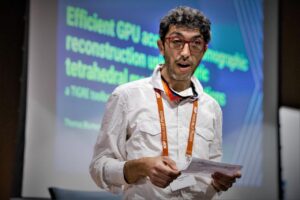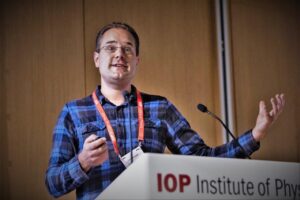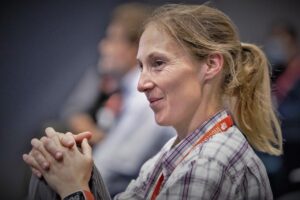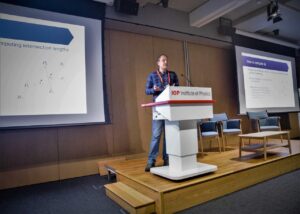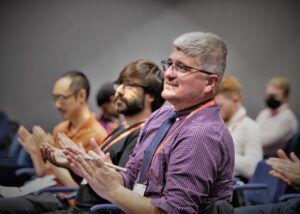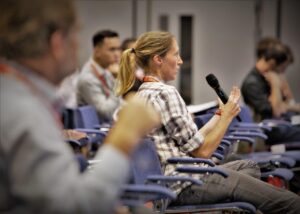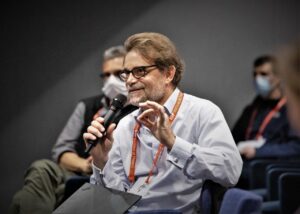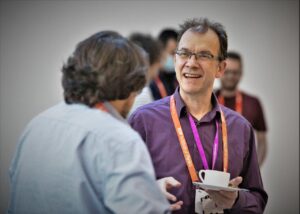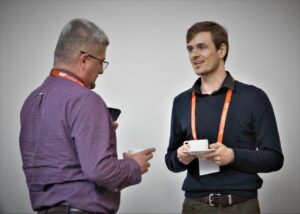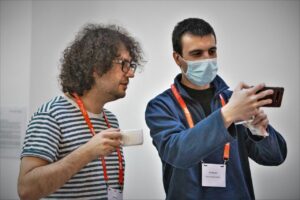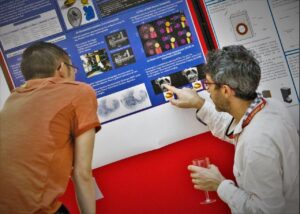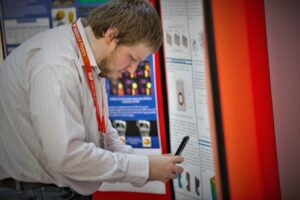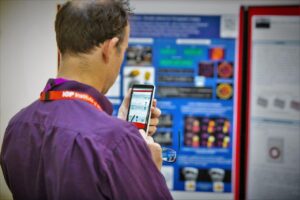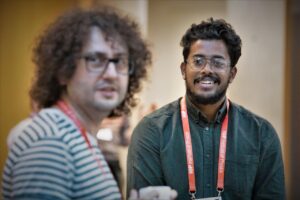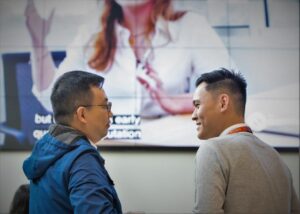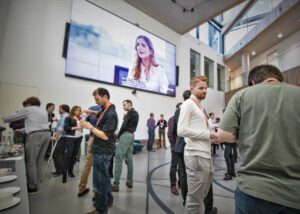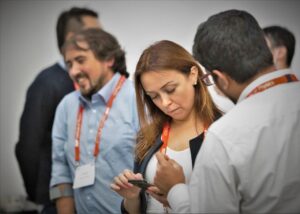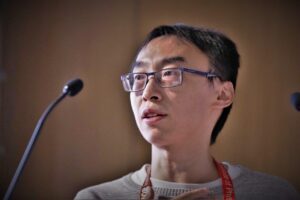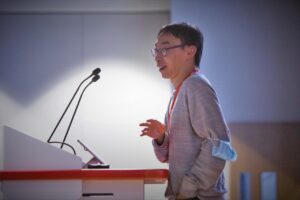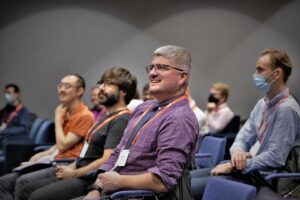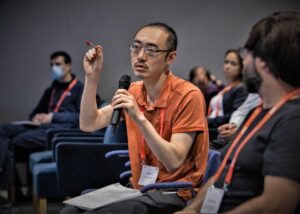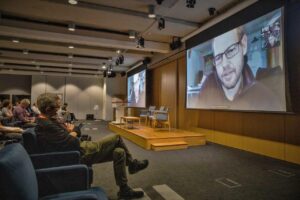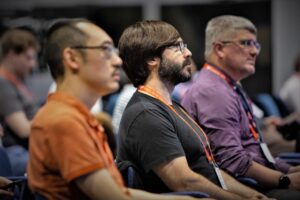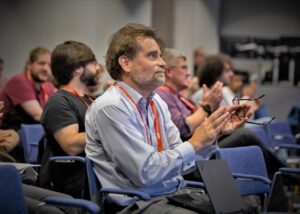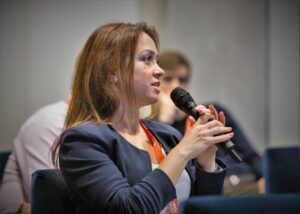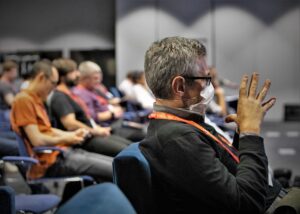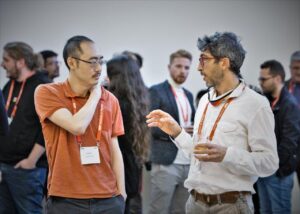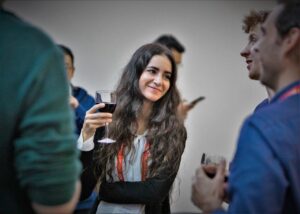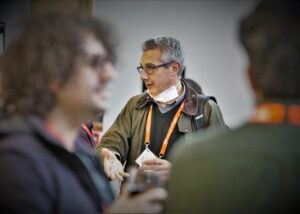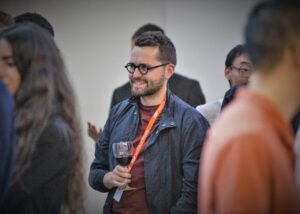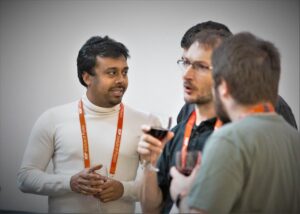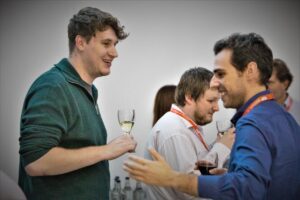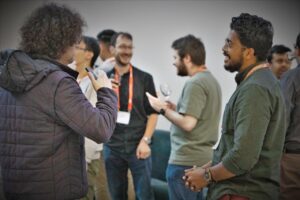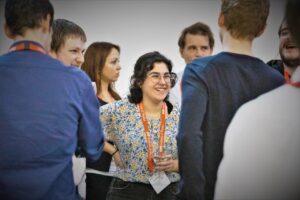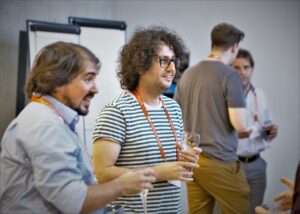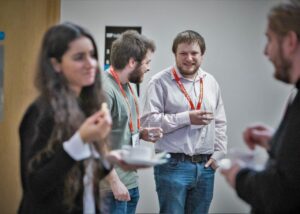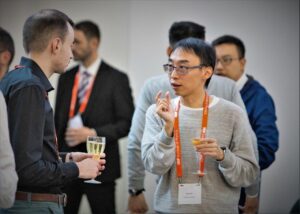Over the four days we had attendees representing academia, research centres, start-up companies and large multinational corporations joining us. Once again, the training course (Day 1-2) was oversubscribed and the forum (Day 3-4) was at capacity under current restrictions for a covid safe environment. For the first time, the event was hosted by the IOP at their headquarters in London.
Keynote Speakers
Prof Jean-Yves Buffiere, INSA, Université de Lyon
Image based simulation of damage development in metals under mechanical loading
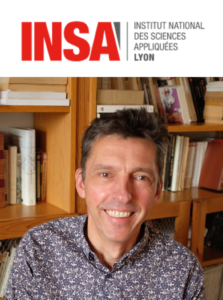 Jean-Yves Buffiere graduated from Grenoble Institut National Polytechnique (INP) in 1989. After a PhD also in Grenoble (1993) and a Post Doc at Imperial College in London he was appointed Associate Professor at Institut National des Sciences Appliquées de Lyon (INSA LYON) in 1994. Since 2003 he is a Professor of Materials Science at INSA (Mechanical Engineering Department). The main focus of his research is on the characterization of damage in advanced metallic materials submitted to mechanical loading. Through collaborations with several synchrotron sources, among which the European Synchrotron Facility (ESRF) in Grenoble, he has pioneered the use of high resolution synchrotron X ray tomography for the non destructive 3D characterization of materials. He has supervised or co-supervised more than 30 PhD projects and post doctoral research programs in the field of fatigue of metals and three dimensional characterization; he is the co-author of more than a 150 papers on that topic and the co-author of a book on 3D Imaging in Mechanics of Materials (Hermes ed. ).
Jean-Yves Buffiere graduated from Grenoble Institut National Polytechnique (INP) in 1989. After a PhD also in Grenoble (1993) and a Post Doc at Imperial College in London he was appointed Associate Professor at Institut National des Sciences Appliquées de Lyon (INSA LYON) in 1994. Since 2003 he is a Professor of Materials Science at INSA (Mechanical Engineering Department). The main focus of his research is on the characterization of damage in advanced metallic materials submitted to mechanical loading. Through collaborations with several synchrotron sources, among which the European Synchrotron Facility (ESRF) in Grenoble, he has pioneered the use of high resolution synchrotron X ray tomography for the non destructive 3D characterization of materials. He has supervised or co-supervised more than 30 PhD projects and post doctoral research programs in the field of fatigue of metals and three dimensional characterization; he is the co-author of more than a 150 papers on that topic and the co-author of a book on 3D Imaging in Mechanics of Materials (Hermes ed. ).
Dr Chu Lun Alex Leung, University College London
Seeing inside powder bed fusion with X-ray imaging and image-based modelling
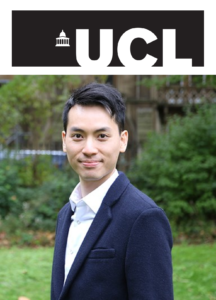 Dr Chu Lun Alex Leung is a Lecturer in Imaging of Advanced Materials and Manufacturing in the Department of Mechanical Engineering at University College London (UCL). Dr. Leung and Prof. Lee are co-leading the Materials, Structure, Manufacturing group at Harwell (MSM@H), UCL, UK Leung’s research focuses on the development of intelligent advanced manufacturing using cutting-edge sensing technologies, including ultra-fast X-ray imaging, X-ray computed tomography and image-based modelling. Before his appointment, he worked as a Postdoctoral Research Fellow at UCL (2018 – 2019) and a Research Associate (2013 – 2017) in the Department of Materials at the University of Manchester, where he obtained his Ph.D. in Materials (2018). His thesis: “X-ray imaging of powder consolidation during laser additive manufacturing” led him to receive 5 individual awards, including the Sir Richard Brook prize (Best Engineering Ph.D. in the UK) sponsored by the Centre for Advanced Structural Ceramics and the Winner of the European Powder Metallurgy Association (EPMA) PM Thesis Competition 2019 sponsored by Högänas AB. Leung has also worked for British Steel (formerly known as Tata Steel Europe) and his last role was working as a New Product Development Project Manager (2011 – 2013). Besides his industrial experience, he earned a Design London fellowship (2009 – 2011) funded by Imperial College London and the Royal College of Art and worked on a product prototype using directable light technology. He received a First Class Honour degree in Aerospace Materials (MEng) and David West prize (2010) from the Department of Materials, Imperial College London.
Dr Chu Lun Alex Leung is a Lecturer in Imaging of Advanced Materials and Manufacturing in the Department of Mechanical Engineering at University College London (UCL). Dr. Leung and Prof. Lee are co-leading the Materials, Structure, Manufacturing group at Harwell (MSM@H), UCL, UK Leung’s research focuses on the development of intelligent advanced manufacturing using cutting-edge sensing technologies, including ultra-fast X-ray imaging, X-ray computed tomography and image-based modelling. Before his appointment, he worked as a Postdoctoral Research Fellow at UCL (2018 – 2019) and a Research Associate (2013 – 2017) in the Department of Materials at the University of Manchester, where he obtained his Ph.D. in Materials (2018). His thesis: “X-ray imaging of powder consolidation during laser additive manufacturing” led him to receive 5 individual awards, including the Sir Richard Brook prize (Best Engineering Ph.D. in the UK) sponsored by the Centre for Advanced Structural Ceramics and the Winner of the European Powder Metallurgy Association (EPMA) PM Thesis Competition 2019 sponsored by Högänas AB. Leung has also worked for British Steel (formerly known as Tata Steel Europe) and his last role was working as a New Product Development Project Manager (2011 – 2013). Besides his industrial experience, he earned a Design London fellowship (2009 – 2011) funded by Imperial College London and the Royal College of Art and worked on a product prototype using directable light technology. He received a First Class Honour degree in Aerospace Materials (MEng) and David West prize (2010) from the Department of Materials, Imperial College London.
Special Invited Speaker
Dr Tim J. Barden, Rolls-Royce plc
Sensors and sensing – Getting to the start line for imaged-based simulation
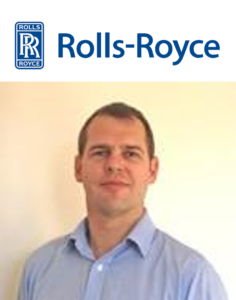 Tim Barden moved to Rolls-Royce having carried out a post-doctorial position at Bath University researching thermal methods for non-destructive evaluation. His role at Rolls-Royce primarily involves the development and introduction of new NDE technologies and is the current Industrial Chair of the Research Centre in Non-Destructive Evaluation.
Tim Barden moved to Rolls-Royce having carried out a post-doctorial position at Bath University researching thermal methods for non-destructive evaluation. His role at Rolls-Royce primarily involves the development and introduction of new NDE technologies and is the current Industrial Chair of the Research Centre in Non-Destructive Evaluation.
Image based simulation has potential benefits to many industries. However, as with all simulation, understanding the inputs is essential and for image based simulation they are varied and each application will have its own limitations. Non-destructive evaluation (NDE) utilises a wide scope of technologies, any physical phenomena that gives information about material integrity could be used as a NDE technique. The same can be said for obtaining data for image based simulation. Modalities include the electromagnetic spectrum, such as optical and x-rays, as well as vibrational waves such as ultrasonics. The variation is further increased by the numerous techniques to stimulate a test object, monitor the response and interpret the output.
The presentation will concentrate on the more common NDE techniques used for obtaining image data including radiography, x-ray computed tomography, ultrasonic and visual. Additionally, general topics will be considered including understanding the quality of the data and reducing artefacts.
Additional Speakers
- Thomas Blumensath, University of Southampton
- Tim Burnett, The University of Manchester
- Ben Callow, Ghent University
- Guillaume Couégnat, Laboratoire des Composites Thermostructuraux (LCTS)
- Wenjia Du, University College London
- David Harman, Synopsys (Northern Europe) Ltd. UK
- Yasasween Hewavidana, Loughborough University
- Martin Jones, The Francis Crick Institute
- Muhammad Sajid Khan, WIDI WALES
- Sebastian Larsen, Imperial College London
- Fabien Leonard, The University of Manchester
- Loic Balazi Atchy Nillama, Cranfield University
- Alessandro Olivo, University College London
- Evangelos Papoutsellis, Science and Technology Facilities Council, UKRI
- Fabrice Pierron, University of Southampton
- Elena Syerko, Ecole Centrale de Nantes, Research Institute in Civil Engineering and Mechanics (GeM)
- Christopher Thornton, University College London
- Nicolas Tonello, Constelcom Ltd
- Franck Vidal, Bangor University
Programme
The majority of the presentations delivered during the workshop (days 3-4) have kindly been made available to download by the authors. Navigate below to the day and session on which the presentation was given and click on the title to download.
Mon 18 Oct 2021
- 9:30 – Registration & Coffee
- 10:00 – Session 1
ORS Dragonfly:
Learn how to take advanced materials and develop (beginning-to-end) fully customized Deep Learning automated segmentation, such that the material is ready for preparing a simulation model (FEM mesh, pixel grid for LBM, pore network model, etc.). - 12:30 – Lunch
- 13:30 – Session 2
ORS Dragonfly (cont.) - 14:45 – Coffee
- 15:15 – Session 3
ORS Dragonfly (cont.) - 17:00 – End
Tue 19 Oct 2021
- 9:00 – Session 4
Iso2Mesh: - 10:30 – Coffee
- 11:00 – Session 5
Iso2Mesh (cont.) - 12:30 – Lunch
- 13:30 – Session 6
VirtualLab: - 14:45 – Coffee
- 15:15 – Session 7
VirtualLab (cont.) - 17:00 – End
Wed 20 Oct 2021
- 9:30 – Registration & Coffee
- 10:00 – Welcome
- 10:15 – Keynote 1
Jean-Yves Buffiere, INSA, Université de Lyon
“Image-based simulation of damage development in metals under mechanical loading.” - 11:00 – Session 1
Tim Burnett, The University of Manchester
“Introduction to the NXCT facility”Wenjia Du, University College London
“3D microstructure and image-based modelling of face coverings”
Sebastian Larsen, Imperial College London
“Deep Semi-supervised Learning of Dynamics for 3D Defect Mapping in Laser Powder Bed Fusion” - 12:15 – Lunch
- 13:15 – Session 2
Fabien Leonard, The University of Manchester
“Global digital volume correlation of large volumes: beyond hardware limitations”
Muhammad Sajid Khan, WIDI WALES
“Skeleton Based Human Action Recognition Using Doubly Linked List”Elena Syerko, Ecole Centrale de Nantes, Research Institute in Civil Engineering and Mechanics (GeM)
“Image Processing Applied to Multi-Scale Textile Reinforcements for Permeability Prediction”Nicolas Tonello, Constelcom Ltd
“A concurrent ecosystem for HPC-powered image visualisation and image-based simulations” - 14:55 – Coffee
- 15:25 – Session 3
Thomas Blumensath, University of Southampton
“Efficient GPU accelerated tomographic reconstruction using generic tetrahedral mesh basis functions: a TIGRE toolbox”
Liang Yang, Cranfield University
“An explicit finite element method for Navier-Stokes-Brinkman equations” - 16:15 – Special Invited Talk
Tim Barden, Rolls-Royce plc
“Sensors and sensing – Getting to the start line for imaged-based simulation” - 16:50 – End
- 17:30-20:00 – Networking Reception
Thu 21 Oct 2021
- 9:30 – Keynote 2
Chu Lun Alex Leung, University College London
“Seeing inside powder bed fusion with X-ray imaging and image-based modelling“ - 10:15 – Session 4a
Christopher Thornton, University College London
“Laser-Plasma Accelerator X-ray Sources and their Applications so far….” - 10:40 – Coffee
- 11:10 – Session 4b
Alessandro Olivo, University College London
“Laboratory-based x-ray phase contrast imaging for NDT and industrial testing”Yasasween Hewavidana, Loughborough University
“3D Fiber Crimp Angle of Nonwoven Materials”Martin Jones, The Francis Crick Institute
“Image analysis of biomedical volume electron microscopy data using deep learning and crowdsourced training data” - 12:25 – Lunch
- 13:25 – Session 5
Fabrice Pierron, University of Southampton
“Measuring deformation from 3D images: the DVC curse”
Guillaume Couégnat, Laboratoire des Composites Thermostructuraux (LCTS)
“Image-based modeling of carbon/carbon and ceramic matrix composites: from X-ray microtomography to finite element models”Franck Vidal, Bangor University
“Optimisation and Simulation of X-ray images: Automatic registration of surface models on synchrotron microtomography data” - 14:40 – Coffee
- 15:10 – Session 6
Edoardo Pasca, Science and Technology Facilities Council, UKRI
“The CCPi Core Imaging Library. A versatile software for tomographic imaging”
Ben Callow, Ghent University
“Unearthing uncertainty – Optimal X-ray micro-CT image-based methods for porosity and permeability quantification in heterogeneous sandstones”David Harman, Synopsys (Northern Europe) Ltd. UK
“An Industrial Workflow for a Non-Destructive Testing and Simulation of Heat Exchanger” - 16:25 – Wrap Up
- 16:40 – Close

